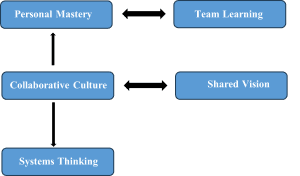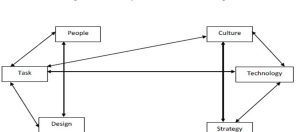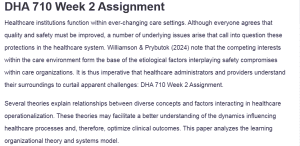DHA 710 Week 2 Assignment
Healthcare institutions function within ever-changing care settings. Although everyone agrees that quality and safety must be improved, a number of underlying issues arise that call into question these protections in the healthcare system. Williamson & Prybutok (2024) note that the competing interests within the care environment form the base of the etiological factors interplaying safety compromises within care organizations. It is thus imperative that healthcare administrators and providers understand their surroundings to curtail apparent challenges: DHA 710 Week 2 Assignment.
Several theories explain relationships between diverse concepts and factors interacting in healthcare operationalization. These theories may facilitate a better understanding of the dynamics influencing healthcare processes and, therefore, optimize clinical outcomes. This paper analyzes the learning organizational theory and systems model.
Overview and Description of the Learning Organizational Theory and Systems Model
Learning Organizational Model
The learning organizational theory is established on the precinct of learning from one’s own mistakes. The theory posits that learning is a continuous process that entails capacity expansion and value addition to create desirable results and an environment where innovative, expansive, and new patterns of thinking and collective aspirations are readily welcomed (Uvhagen et al., 2024).
Several theoretical concepts emanate from the learning organizational theory. These include team learning, personal mastery, systems thinking, shared vision, and collaborative culture. Team learning refers to expanding a member’s capacity to attain desired results. It recognizes that organizational learning is a collective responsibility and implores members to dialogue and foster information sharing and open communication in their pursuit of improvement (Uvhagen et al., 2024).
Personal mastery borders on individual commitment to growth and learning. This conceptual framework provides that the learning process stretches beyond acquiring knowledge to developing and applying skills that are valuable to the organization (Uvhagen et al., 2024). Systems thinking, on the other hand, refers to the ability of organizational members to understand how different aspects of the organization are connected. It also fosters the recognition of the factors that interplay in organizational operationalization and how they can leverage various tools to obtain the desired results.
Shared vision and collaborative cultures are other concepts of the learning organizational theory. Shared vision is a forward-thinking approach that involves members converging towards a specific goal. Collaborative cultures, on the other hand, refer to an environment where members work together regardless of their level in the scalar chain of command to ensure organizational goals and purposes are met.

Systems Model of Change
The systems model of change provides a pathway for analyzing, implementing, and managing the change process within the organization. The systems model of change postulates that change processes are a system-wide endeavor that should be implemented at the organizational level rather than piecemeal. The theory further suggests that there are six interconnected and interdependent variables that play a role within the organization. These are the people, strategy, design, culture, task, and technology (Gadsby & Wilding, 2024).
The people refer to persons working within the organization. It encompasses individual differences that manifest in the forms of perceptions, beliefs, value systems, attributions, personal goals, and needs. Strategy, on the other hand, refers to the roadmap towards meeting organizational goals and objectives.
Design refers to the organizational structure, including the scalar chain of command, system of communications, and authority. Culture refers to the organization’s shared beliefs, expectations, and norms. It influences the level of adoption of various change processes and may impact member wellness. A positive culture is warranted for systems change within organizations.
Task and technology are other variables of the systems model of change. Task refers to the work handled by organizational members. Tasks may be simple, repetitive, complex, or standardized.
Administrators scrutinize each task and draw a pathway for delivering it. Technology, on the other hand, is using technological advances to enhance operationalizations within the organization.

Compare and Contrast
The learning organizational theory and the systems model of change delve into divergent yet interrelated aspects of healthcare systems and operationalizations. There are several similarities and differences in the phenomenon drawn from the models. The comparison parameters border on change management and systems thinking phenomena within organizations. Both focus on change processes within organizations.
They highlight the significance of positive changes in improving organizational outcomes and why organizations should focus on planning and implementing meaningful changes to expand their presence within the systems they operate. However, they differ in their approach. The learning organizational theory sees change as a core organizational feature required for the organization to survive. The systems model, on the other hand, views change as something triggered externally but necessary in perpetuating the growth of the organization.
The models also have some similarities in their approach to systems thinking. Both highlight systems thinking as a vital component of an organization’s success. It encourages thinking as a single unit rather than interrelated parts. They, however, differ in their approach.
The learning organizational theory implores organizations to shift towards interconnectedness in their thought processes. The systems model, on the other hand, defines concepts that explain why a change system will behave in a certain manner (Talukder et al., 2024).
The overarching elements in each model contribute to the overall understanding of its theoretical postulates. The components of each model differ significantly. Foremost, the principles of learning organization theory help in explaining why learning is necessary for organizational prosperity.
The five concepts detailed in the model build on the significance of learning and how organizations can leverage them to ensure success. Contrarily, the systems model details specific aspects required to ensure successful change. It highlights the interconnectedness of the parts and the need to address them as a unit to promote growth within an organization.
Consistently, the systems model of change and learning organizational change theories complement one another in explaining organizations as systems. Whereas the systems model explains the interconnectedness of the individual parts and the need to view them as a unit, the learning organizational theory highlights the significance of integrating learning processes into the organization’s operational frameworks. Both theories are integral to the thriving of care organizations as they highlight the significance of change and the mechanisms necessary to foster meaningful changes within care organizations.
Complex Adaptive Systems (CAS) Thinking
The CAS thinking refers to a way of analyzing organizations and systems by considering the influence individual components relate with, influence, and work with one another. The two theories support CAS thinking in many ways. The learning organizational theory views the learning processes as a progressive process and organizations as learning systems. This means the organization must continually provide learning opportunities to its members to ensure success.
This provision concurs with the CAS lever points where small actions result in a larger system change. The systems model of change posits that organizational variables are interdependent and that a change in one variable will impact others, which is aligned with the concept of element adaptability described in CAS, where elements in a system can change themselves and have an impact on the system (Ahmad et al., 2024).
Theoretical models provide insights into organizational operationalizations and success. The learning organizational theory and the systems model of change provide an understanding of how systems and organizations operate. They also demonstrate how organizational components can be leveraged to effect meaningful changes within the organization.
References
Ahmad, M. A., Baryannis, G., & Hill, R. (2024). Defining complex adaptive systems: An algorithmic approach. Systems, 12(2), 45. https://doi.org/10.3390/systems12020045
Gadsby, E. W., & Wilding, H. (2024). Systems thinking in, and for, public health: A call for a broader path. Health Promotion International, 39(4). https://doi.org/10.1093/heapro/daae086
Talukder, B., Schubert, J. E., Tofighi, M., Likongwe, P. J., Choi, E. Y., Mphepo, G. Y., Asgary, A., Bunch, M. J., Chiotha, S. S., Matthew, R., Sanders, B. F., Hipel, K. W., vanLoon, G. W., & Orbinski, J. (2024). Complex adaptive systems-based framework for modeling the health impacts of climate change. The Journal of Climate Change and Health, 15, 100292. https://doi.org/10.1016/j.joclim.2023.100292
Uvhagen, H., Gärdegård, A., & Klinga, C. (2024). Through the lens of learning organization theory: Strategies used when introducing new work methods as described by practitioners and leaders in social services. Nordic Social Work Research, 1–17. https://doi.org/10.1080/2156857x.2024.2329945
Williamson, S. M., & Prybutok, V. (2024). Balancing Privacy and Progress: A Review of Privacy Challenges, Systemic Oversight, and patient perceptions in AI-driven healthcare. Applied Sciences, 14(2), 675. https://doi.org/10.3390/app14020675
ORDER A PLAGIARISM-FREE PAPER HERE
We’ll write everything from scratch
Question 
Upon completion of this first of three parts to your Integrative Paper, you will have laid the foundation of systems theories and models that you will apply to a problem or innovation opportunity at a health care organization of your choosing.
Read the Integrative Paper Guidelines to prepare you for this set of three assignments during this course. (ATTACHED)
Choose 2 topics from the list of systems theories and conceptual models below:
- General systems theory
- Chaos theory
- Complexity theory
- Learning organization theory
- Systems model of change
- Viable systems model

DHA 710 Week 2 Assignment
Write a 1,050- to 1,225-word paper in which you do the following:
- Describe each of the 2 selected theories/models including an overview and details in the form of key elements and relationships between the elements. Visual depictions are encouraged.
- Compare and contrast the 2 selected theories/models. Consider the following:
- What phenomenon or phenomena is the theory or model addressing?
- How are the elements of each theory/model similar? How do they differ?
- Where do the theories/models complement one another in explaining organizations as systems?
- Explain what complex adaptive systems (CAS) thinking is and how the 2 theories/models inform or support CAS. A visual depiction of CAS is encouraged.
Note: This paper will become the “Breadth” section of your final integrative paper. Please use only 2024 references.